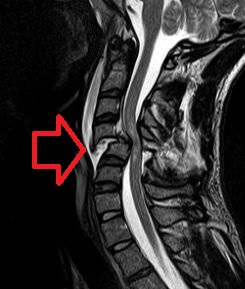Spinal Cord Injury
| Spinal cord injury | |
|---|---|
 |
|
| MRI of fractured and dislocated neck vertebra that is compressing the spinal cord | |
| Classification and external resources | |
| Specialty | Neurosurgery |
| ICD-10 | G95.9, T09.3 |
| DiseasesDB | 12327 29466 |
| MedlinePlus | 001066 000029 |
| eMedicine | emerg/553 neuro/711 pmr/182 pmr/183 orthoped/425 |
| MeSH | D013119 |
A spinal cord injury (SCI) is damage to the spinal cord that causes changes in its function, either temporary or permanent. These changes translate into loss of muscle function, sensation, or autonomic function in parts of the body served by the spinal cord below the level of the lesion. Injuries can occur at any level of the spinal cord and can be classified as complete injury, a total loss of sensation and muscle function, or incomplete, meaning some nervous signals are able to travel past the injured area of the cord. Depending on the location and severity of damage along the spinal cord, the symptoms can vary widely, from pain or numbness to paralysis to incontinence. The prognosis also ranges widely, from full recovery in rare cases to permanent tetraplegia (also called quadriplegia) in injuries at the level of the neck, and paraplegia in lower injuries. Complications that can occur in the short and long term after injury include muscle atrophy, pressure sores, infections, and respiratory problems.
In the majority of cases the damage results from physical trauma such as car accidents, gunshots, falls, or sports injuries, but it can also result from nontraumatic causes such as infection, insufficient blood flow, and tumors. Efforts to prevent SCI include individual measures such as using safety equipment, societal measures such as safety regulations in sports and traffic, and improvements to equipment. Known since ancient times to be a catastrophic injury and long believed to be untreatable, SCI has seen great improvements in its care since the middle of the 20th century. Treatment of spinal cord injuries starts with stabilizing the spine and controlling inflammation to prevent further damage. Other interventions needed can vary widely depending on the location and extent of the injury, from bed rest to surgery. In many cases, spinal cord injuries require substantial, long-term physical and occupational therapy in rehabilitation, especially if they interfere with activities of daily living. Research into new treatments for spinal cord injuries includes stem cell implantation, engineered materials for tissue support, and wearable robotic exoskeletons.
...
Wikipedia
